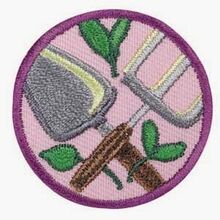| Line 63: | Line 63: | ||
==Activity #5: Grow your own garden== |
==Activity #5: Grow your own garden== |
||
| + | |||
| − | '''Create your own garden with the six plants you found in step 3, six from a nursery, or six from a friend or neighbor who really loves to garden. Follow the spacing and planting directions that come with them, and be sure to ask for help with planting and permission for your space.''' |
||
CHOICES – DO ONE: |
CHOICES – DO ONE: |
||
| Line 72: | Line 72: | ||
'''Plant an indoor garden. '''Houseplants can be part of beautiful indoor gardens. If you have access to a greenhouse or hothouse, you could grow your indoor garden there – or perhaps at a sunny spot inside your own home! |
'''Plant an indoor garden. '''Houseplants can be part of beautiful indoor gardens. If you have access to a greenhouse or hothouse, you could grow your indoor garden there – or perhaps at a sunny spot inside your own home! |
||
| − | |||
| − | '''OR''' |
||
| − | |||
| − | '''Help with planting at a community or school garden. '''Many schools and cities offer public gardening spaces. There might be a garden at your place of worship, your library, or in front of town hall. Perhaps one of these places could use your gardening help? |
||
[[Category:Juniors]] |
[[Category:Juniors]] |
||
[[Category:It's Your Planet-Love It!]] |
[[Category:It's Your Planet-Love It!]] |
||
Revision as of 20:27, 13 February 2020

Junior Gardener Badge
The Gardener badge is part of the “It's Your Planet - Love It!” badge set introduced in 2011.
Girl Scout Juniors learn how to help plants and flowers grow.
This badge obviously works better if started in the early Spring, although some could be done in the Fall with planting bulbs (tulips, daffodils, crocuses, etc.).
Activity #1: Visit a garden
The best way to get inspired about gardening is to explore and enjoy a well-cared-for garden. Take a tour of one of the gardens below to start learning about how gardens are planted, how to take care of them, and the right way to pick flowers when they’ve blossomed.
CHOICES – DO ONE:
Visit an outdoor garden. Check out a garden in a public space in your community. Take photos or make sketches or drawings of your favorite plants in case you decide to grow them yourself. Ask how they grow!
BE A GARDEN MATH WHIZ! Gardens are full of flowers – and math, too! Did you think of these bits of garden math?
¤ Seed packets have directions that tell you how deep and how far apart to plant the seeds.
You’ll use math to figure out how many seeds can fit in your garden.
Plant under the full sun
1/4in. into soil
Scatter so plants aren’t right on top of each other.
Different plants grow to different heights. Read the seed packages for instructions.
¤ When you buy a bag of tomatoes or a dozen roses at the store, you often pay more than you
would have if you bought the seeds or plants and grew them yourself. You might save your
family some money with your garden – can you figure out how much?
¤ Many people think a flower bed looks best with short flowers in front and tall ones in back.
Seed packets and flower tags will tell you how tall they’ll become and how soon they’ll bloom,
but you’ll get to do the math!
Activity #2: Explore garden design
The first gardens on record were planted in Persia 4,000 years ago. Humans have long known that well-designed gardens can have magical effects – they can make people feel cheerful, thoughtful, or inspired. What kind do you want?
Look into surprising gardens. Gather information about three gardens. Try to find out who designed them and how they did it. What about rooftop gardens, English landscape gardens, palace gardens, midnight gardens, or gardens meant to attract certain insects or animal? Then, imagine a special garden of your own. Share your idea in a sketch.
Activity #3: Learn how to choose garden plants
Before you begin planting a garden, you have to learn how plants grow. For help, ask a gardening expert. In each choice, ask your helper how much water and sunlight a plant will need to stay healthy.
Find six plants that grow in different ways. A gardener can begin to grow a plant from a seed, a bulb, or from roots. Find two plants you could grow from seeds, two from bulbs, and two from roots that are likely to do well in your garden.
Activity #4: Experiment with seeds
Window Gardening There are plenty of plants you can grow from inside your home! All plants like light, so they can grow nicely on a windowsill. Some plants need lots of light, and some don’t need very much at all.
Find out which direction your window faces before you choose your plants. North-facing windows usually don’t receive a lot of light. Ferns and ivy grow well with little light. If your window faces the south, a sun-loving plant like a geranium will thrive. East-and west-facing windows both needs plants that like indirect sunlight.
Talk to an expert about choosing the best options for your windows.
Activity #5: Grow your own garden
CHOICES – DO ONE:
Plant an outdoor garden. If you have access to a yard, perhaps there’s a plot you can use. Or, you might plant a garden in a small planter or an outdoor window box.
OR
Plant an indoor garden. Houseplants can be part of beautiful indoor gardens. If you have access to a greenhouse or hothouse, you could grow your indoor garden there – or perhaps at a sunny spot inside your own home!